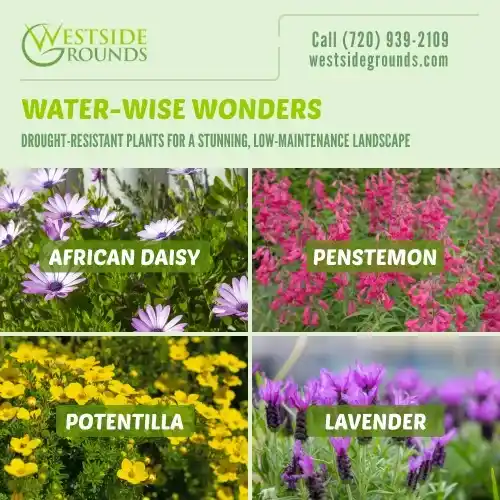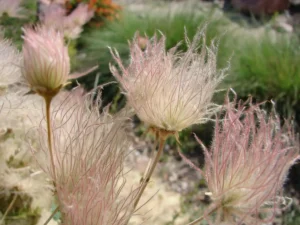List of Drought Tolerant Plants

- Apache Plume
- Blue Avena Grass
- Catmint
- Coral Bells
- Fernbush
- Golden Currant
- Russian Sage
Consider the possibility of droughts when designing your landscape. Droughts are a possible phenomenon in Colorado. If a drought hits, you’ll have to conserve water, which means less for your landscape. No one wants to see dead plants and brown patches on your grass.
Planting drought-tolerant plants in Colorado is a way to avoid this issue. These plants can adapt to droughts and survive without much water. Read on to learn more about drought-tolerant plants.
What Are Drought Tolerant Plants?
Drought tolerant plants can thrive during drought conditions, needing only a little water to survive. These plants have specific characteristics that allow them to survive with less water, such as deep roots (which make it easier to absorb moisture in the soil) and small leaves (which prevent moisture from leaving the plant).
Drought-tolerant plants also vary in the amount of sunlight they need. Some of these plants are full-sun drought-tolerant plants, which means they still require a significant amount of sunlight to grow, which is at least six hours a day.
On the other hand, full drought-tolerant shade plants in Colorado can still thrive in the shade and require only a few hours of sunlight a day.
Partial-shade or partial-sun drought-tolerant plants need between four and six hours of sun each day to thrive.
Get a Custom Drought‑Tolerant Landscape Plan Today
What Are Some Examples of Drought Tolerant Plants?
Here are some examples of drought-tolerant plants in Colorado.
Apache Plume (Fallugia paradoxa)

Apache plume is a shrub with white stems and green leaves. In the summer, white flowers blossom, and later, pink plumes grow. These plants are very beneficial to the environment. They provide shelter for wildlife, and their seeds provide food for birds.
Blue Avena Grass (Helictotrichon sempervirens)
Blue avena grass has silver-bluish colored blades. It can stand two to three feet high. During the summer months, straw spikes sprout from the blades. Blue avena grass can withstand harsh weather conditions and is resistant to nuisances like insects and fungi.
Catmint (Neoeta cataria)
Catmint is a perennial plant, which means it grows all year round. It is greenish with flower spikes that can be pink, white, blue, or lavender colored. It requires little maintenance and is not easily plagued by insects and disease.
Coral Bells (Heuchera)
Coral bell foliage can range from green to silver-green to burgundy. Its flowers can be red or white.
Coral bells can thrive in both the shade and full sun. However, don’t leave them out when the sun is at its highest. If you do, they will need more water. They prefer part shade.
Fernbush (Chamaebatiaria millefolium)
A fernbush is a shrub that resembles a fern. Its flowers turn white during the late spring and early summer months. Fernbushes require little maintenance.
Golden Currant (Ribes aureum)
A golden currant plant grows black fruit. It is a full-sun drought-tolerant plant, though it can also grow in the shade. If in the shade, it won’t produce as much fruit.
Russian Sage (Perovskia atriplicifolia)
A Russian sage is a highly adaptable plant. It is vibrant with bright purple flowers and can stand almost half a foot high. It can also withstand pests and wildlife that may try to wreak havoc.
What Are the Benefits of Drought Tolerant Plants?
Adding only drought tolerant plants to your landscape has many benefits, such as the following.
Money Savers
Utility bills are getting more and more expensive. You don’t need to add more expenses to your landscape project. By adding drought tolerant plants, you won’t have to worry about an increase in your water bill.
Because drought tolerant plants do not require as much water to survive, you will save money on them.
Native Plants
Many Colorado native plants are drought tolerant, such as the following:
- Bluestem grass (Andropogon gerardii),
- Chocolate flower (Berlandiera lyrata),
- Fringed sage (Artemisia frigida),
- Rocky Mountain juniper (Juniperus scopulorum),
- Rocky Mountain penstemon (Penstemon strictus), and
- Santa Fe aster (Machaeranthera bigelovii).
These plants are very beneficial to the environment. Native plants provide wildlife with food and shelter. They also repopulate native vegetation in Colorado that has been lost from urbanization.
Water Conservation
Another environmental aspect of drought tolerant plants is water conservation. Because you don’t have to use so much water to keep drought tolerant plants alive, you can preserve water, which is particularly important in the summer when droughts can plague Colorado cities.
Hire a Professional for Your Landscape
You can choose from many different drought tolerant plants. The list here is not nonexhaustive. Look to the professionals at Westside Grounds to help you choose the plants for your property. We understand which plants are compatible with each other and which soils are the best.
Westside Grounds has served the communities of Denver and Lakewood for 25 years since 1999. Contact us and speak to one of our representatives to learn more about our complete landscaping and maintenance services.
